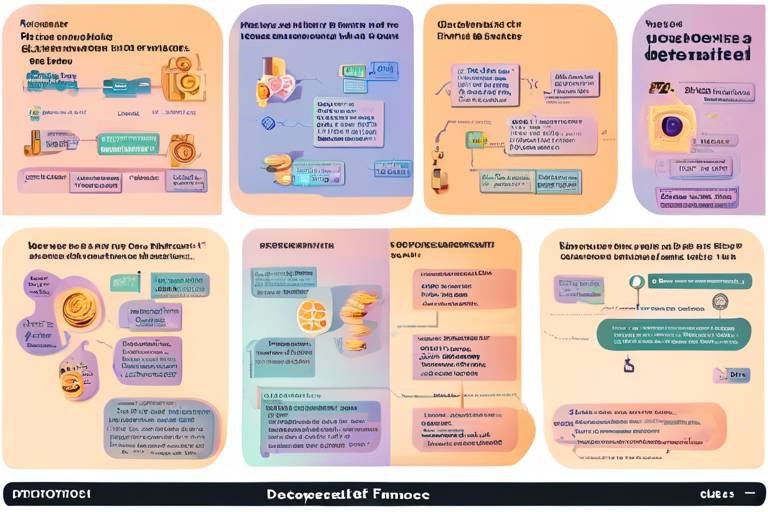Understanding the Global Landscape of Blockchain Regulations
The world of blockchain technology is like a vast ocean, teeming with potential yet fraught with uncertainty. As businesses and individuals dive into this digital frontier, understanding the regulatory landscape becomes essential. Regulations serve as the lifeguards of this ocean, ensuring that innovation can flourish while protecting consumers and maintaining market integrity. But why is it so crucial to navigate these waters carefully?
In recent years, the rapid growth of blockchain and cryptocurrency has prompted governments and regulatory bodies worldwide to take a closer look at how to manage this emerging technology. The challenge lies in crafting regulations that are not only effective but also adaptable to the fast-paced nature of the digital world. Think of regulations as the rules of a game; without them, players might take advantage of loopholes, leading to chaos rather than fair competition.
The importance of blockchain regulations can be summed up in a few key points:
- Fostering Trust: Regulations help build trust among users and investors by ensuring that companies adhere to certain standards.
- Promoting Innovation: A clear regulatory framework can encourage innovation by providing businesses with the confidence to invest in new technologies.
- Ensuring Consumer Protection: Regulations safeguard consumers against fraud and other risks associated with blockchain technology.
As we explore the global landscape of blockchain regulations, it's important to recognize that different countries have taken varied approaches based on their unique economic priorities and cultural attitudes. Some nations embrace blockchain as a catalyst for growth, while others remain cautious, focusing on potential risks. This divergence creates a complex tapestry of regulations that can be both exciting and daunting for those looking to engage with blockchain technology.
In the coming sections, we will delve deeper into the roles of key regulatory bodies, the international frameworks that influence local laws, and the challenges faced by regulators in this ever-evolving landscape. By understanding these elements, stakeholders can better navigate the regulatory waters, ensuring they remain compliant while harnessing the full potential of blockchain technology.
- What is blockchain technology? Blockchain is a decentralized ledger technology that enables secure and transparent transactions without the need for intermediaries.
- Why are regulations important for blockchain? Regulations help ensure consumer protection, foster trust, and promote innovation within the blockchain ecosystem.
- How do different countries regulate blockchain? Countries adopt unique regulatory approaches based on their economic priorities, technological readiness, and cultural attitudes towards innovation.

The Importance of Blockchain Regulations
In today's fast-paced digital world, where innovation is the name of the game, understanding the importance of blockchain regulations is crucial. These regulations serve as the backbone of a secure and trustworthy environment for blockchain technology. Without them, we risk plunging into a chaotic landscape where fraud and misuse could run rampant. But why are these regulations so essential? Let’s break it down.
First and foremost, blockchain regulations help to foster trust among users and businesses. Imagine a world where everyone could interact without the fear of scams or data breaches. Regulations set standards that help ensure transactions are secure and transparent. This trust is vital for encouraging more individuals and businesses to adopt blockchain technology, paving the way for innovation and growth.
Moreover, regulations play a significant role in promoting innovation. While it may seem counterintuitive, a well-regulated environment can actually spur creativity. Think of it like a sports game: rules are put in place to ensure fair play, but they also provide a framework within which players can showcase their skills. Similarly, regulations can offer a clear path for developers and entrepreneurs, allowing them to explore new ideas without fear of legal repercussions.
Another critical aspect of blockchain regulations is consumer protection. In a decentralized world, consumers often find themselves vulnerable to risks. Regulations can help safeguard users by ensuring that businesses adhere to specific standards, thus minimizing the chances of exploitation. For instance, regulations can mandate transparency in how user data is handled, giving consumers peace of mind when engaging with blockchain platforms.
To illustrate the multifaceted role of blockchain regulations, consider the following key points:
- Fostering Trust: Establishing a reliable framework for users.
- Encouraging Innovation: Providing a safe space for creative solutions.
- Protecting Consumers: Ensuring businesses follow ethical practices.
In essence, blockchain regulations are not merely bureaucratic hurdles; they are essential components that can drive the technology forward. The balance between regulation and innovation is delicate, but when done right, it can lead to a thriving ecosystem that benefits everyone involved. As we move forward, the challenge lies in crafting regulations that are both effective and adaptable, ensuring they keep pace with the rapid evolution of blockchain technology.

Key Regulatory Bodies and Their Roles
When diving into the intricate world of blockchain regulations, it's essential to recognize the pivotal role played by various regulatory bodies. These organizations are not just gatekeepers; they are the architects of the frameworks that govern blockchain technology and cryptocurrency operations. Their influence extends across borders, shaping how businesses innovate and ensuring that consumers are protected in this digital frontier.
At the forefront of blockchain regulation are several key bodies, each with its unique mandate and jurisdiction. For instance, the Financial Action Task Force (FATF) is instrumental in establishing international standards to combat money laundering and terrorist financing, which directly impacts how blockchain transactions are monitored. Similarly, the International Organization of Securities Commissions (IOSCO) plays a crucial role in setting global standards for securities regulation, affecting how cryptocurrencies are classified and treated in various markets.
In the United States, the regulatory landscape is particularly complex. The Securities and Exchange Commission (SEC) is one of the most influential bodies, responsible for regulating securities and protecting investors. Its stance on whether certain cryptocurrencies qualify as securities has significant implications for blockchain startups and established companies alike. On the other hand, the Commodity Futures Trading Commission (CFTC) oversees derivatives and futures markets, providing guidance on how digital assets may be traded in these formats. This dual oversight can create a challenging environment for companies trying to navigate compliance.
Across the pond, the European Securities and Markets Authority (ESMA) works to enhance investor protection and promote stable and orderly financial markets in the EU. Its regulations, particularly in light of the Markets in Crypto-Assets (MiCA) proposal, aim to streamline the regulatory framework for digital assets, allowing for a more cohesive approach across member states. This is crucial for businesses operating in multiple jurisdictions, as it reduces the regulatory burden and fosters innovation.
In addition to these major players, many countries have established their regulatory bodies to address the unique challenges posed by blockchain technology. For example, the Monetary Authority of Singapore (MAS) has been proactive in creating a regulatory environment that encourages innovation while ensuring consumer protection. Their approach serves as a model for other nations looking to balance the benefits of blockchain with the need for regulation.
To summarize, the regulatory bodies overseeing blockchain technology are diverse and multifaceted, each contributing to a complex web of rules that govern this rapidly evolving space. Their roles are not merely bureaucratic; they are essential for fostering an environment where innovation can thrive while ensuring that consumers are safeguarded. As the blockchain landscape continues to evolve, the importance of these regulatory bodies will only increase, shaping the future of technology and finance.
- What is the role of regulatory bodies in blockchain technology? Regulatory bodies establish frameworks and guidelines that govern the use of blockchain technology, ensuring consumer protection and fostering innovation.
- How does the SEC influence blockchain regulation in the U.S.? The SEC determines whether cryptocurrencies are classified as securities, impacting how they can be traded and the compliance requirements for companies.
- What is the MiCA proposal in the EU? The Markets in Crypto-Assets (MiCA) proposal aims to create a comprehensive regulatory framework for digital assets across EU member states.
- Why is international cooperation important in blockchain regulation? International cooperation helps create consistent regulations across borders, which is crucial for businesses operating globally and for preventing regulatory arbitrage.

International Regulatory Frameworks
The global landscape of blockchain regulation is as intricate as the technology itself. As nations grapple with the opportunities and challenges posed by blockchain, various have emerged, each aiming to create a cohesive environment for innovation while ensuring compliance and security. These frameworks serve as guiding principles, influencing national regulations and fostering cross-border cooperation among regulators. Imagine them as the rulebook for a game that is still being defined, where every player—be it a country, a business, or an individual—must understand their role and responsibilities.
One of the most significant aspects of these frameworks is their ability to shape national policies. Countries often look to international guidelines when drafting their own regulations, ensuring that they remain competitive while also protecting their citizens. For instance, the Financial Action Task Force (FATF) has established guidelines that many countries adopt to combat money laundering and terrorist financing in the context of cryptocurrency. This not only helps to standardize regulations but also promotes a sense of trust in the technology.
Another critical player in the international arena is the International Organization of Securities Commissions (IOSCO), which focuses on the regulation of securities markets. IOSCO's principles provide a framework for securities regulation that many countries use when considering how to treat blockchain-based assets. This is crucial, as the classification of these assets can significantly impact how they are regulated and taxed.
As we dive deeper into the role of these international frameworks, it’s essential to recognize the balance they strive to achieve. On one hand, they aim to foster innovation and allow for the rapid development of blockchain technologies. On the other hand, they must ensure that consumer protection and market integrity are not compromised. This balancing act is akin to walking a tightrope—too much regulation can stifle innovation, while too little can lead to chaos and exploitation.
In summary, international regulatory frameworks play a pivotal role in shaping the future of blockchain technology. By providing guidelines that influence national regulations, these frameworks help create a safer and more predictable environment for businesses and consumers alike. As the world becomes increasingly interconnected, the importance of these frameworks will only grow, making it essential for stakeholders to stay informed and engaged in the regulatory conversation.
- What is the purpose of international regulatory frameworks for blockchain?
These frameworks aim to standardize regulations across countries, promote cooperation among regulators, and ensure consumer protection while fostering innovation.
- How do international frameworks influence national regulations?
Countries often look to international guidelines when formulating their own regulations, ensuring they remain competitive and compliant with global standards.
- What are some key international regulatory bodies?
Notable bodies include the Financial Action Task Force (FATF) and the International Organization of Securities Commissions (IOSCO), both of which provide essential guidelines for blockchain and cryptocurrency regulation.

European Union Regulations
The European Union (EU) has taken a proactive stance in regulating blockchain technology and cryptocurrencies, recognizing the potential these innovations hold for transforming economies and enhancing digital services. At the heart of this regulatory approach is the **Markets in Crypto-Assets (MiCA)** proposal, which aims to create a comprehensive framework for the crypto industry across all EU member states. This initiative is pivotal in establishing a unified regulatory environment, ensuring that businesses can operate seamlessly across borders while adhering to common standards.
MiCA is designed to address various aspects of the crypto market, including the issuance of crypto-assets, the operation of crypto exchanges, and the provision of wallet services. By implementing these regulations, the EU seeks to foster **consumer protection**, mitigate risks associated with fraud and market manipulation, and promote fair competition among market participants. It's akin to laying down the rules in a game—ensuring everyone plays fair and knows what to expect.
Moreover, the EU's regulatory framework emphasizes **transparency** and **accountability**. For instance, under MiCA, crypto-asset service providers will be required to disclose detailed information about their operations, which will help consumers make informed decisions. This transparency is crucial in a space often criticized for its opacity, where users can feel lost in a sea of jargon and complex technologies. Think of it as turning on the lights in a dimly lit room; suddenly, everything becomes clearer.
In addition to MiCA, the EU is also exploring the **Digital Operational Resilience Act (DORA)**, which aims to strengthen the cybersecurity and operational resilience of financial institutions, including those involved in blockchain technology. This act is essential as it recognizes that with great innovation comes great responsibility. The EU is not just focused on enabling innovation; it is equally concerned with safeguarding the integrity of the financial system.
As we look towards the future, the EU's approach to blockchain regulation will likely continue to evolve. The balance between fostering innovation and ensuring consumer protection is a delicate one, and the EU seems committed to getting it right. By establishing a robust regulatory framework, the EU not only aims to protect its citizens but also to position itself as a leader in the global blockchain landscape.
In conclusion, the EU's regulatory efforts, particularly through initiatives like MiCA and DORA, represent a significant step towards creating a safe and thriving environment for blockchain technology. As these regulations come into effect, businesses operating in this space will need to stay informed and adapt to the changing landscape, ensuring compliance while continuing to innovate.
- What is the MiCA proposal?
The MiCA proposal is a regulatory framework introduced by the European Union aimed at governing the crypto-assets market, ensuring consumer protection, and fostering innovation across member states.
- How does the EU ensure consumer protection in blockchain?
The EU emphasizes transparency and accountability through regulations that require crypto-asset service providers to disclose operational details, helping consumers make informed decisions.
- What is the Digital Operational Resilience Act (DORA)?
DORA is an initiative aimed at enhancing the cybersecurity and operational resilience of financial institutions, including those that utilize blockchain technology.
- Why is a unified regulatory framework important?
A unified regulatory framework allows businesses to operate across borders without facing varying regulations in each member state, promoting fair competition and innovation.

United States Regulatory Landscape
The regulatory landscape for blockchain technology in the United States is as intricate as a spider's web, woven with various agencies and a multitude of regulations that can leave even the most seasoned professionals scratching their heads. At the forefront of this regulatory framework are two key players: the U.S. Securities and Exchange Commission (SEC) and the Commodity Futures Trading Commission (CFTC). These agencies are tasked with overseeing the compliance of blockchain and cryptocurrency projects, ensuring that they adhere to existing laws while promoting innovation.
The SEC primarily focuses on securities regulation. This means that if a blockchain project is deemed to be offering securities, it must comply with SEC rules, which include registering the offering or qualifying for an exemption. The SEC's stance has often been cautious, leaning towards stringent scrutiny to protect investors. For example, initial coin offerings (ICOs) have been a hot topic, with the SEC declaring many ICOs as securities offerings, thus requiring them to meet specific regulatory obligations.
On the other hand, the CFTC takes a different approach, viewing certain cryptocurrencies as commodities. This distinction allows the CFTC to regulate derivatives and futures contracts based on these digital assets. The CFTC's role is crucial as it provides a framework for trading and ensures that market participants adhere to fair practices. The agency has also been proactive in addressing fraud and manipulation in the cryptocurrency markets, emphasizing the need for a balanced approach that fosters innovation while safeguarding consumers.
However, the U.S. regulatory landscape is not just a tale of two agencies. Numerous other bodies, such as the Financial Crimes Enforcement Network (FinCEN) and state regulatory agencies, play a vital role in shaping the compliance requirements for blockchain businesses. FinCEN, for instance, enforces anti-money laundering (AML) regulations and requires cryptocurrency exchanges to register as money services businesses (MSBs). This creates an additional layer of compliance that businesses must navigate, often leading to confusion and operational challenges.
Moreover, the lack of a cohesive federal framework means that states can impose their own regulations, resulting in a patchwork of laws that vary significantly across the country. For example, New York's BitLicense requires cryptocurrency businesses to obtain a special license, while other states may have more lenient requirements. This inconsistency can deter innovation, as startups may hesitate to enter markets with uncertain regulatory environments.
In response to these challenges, there have been calls for clearer guidelines and a more unified approach to blockchain regulation in the U.S. Stakeholders, including industry leaders and policymakers, are advocating for a framework that supports technological advancement while ensuring consumer protection. As the landscape continues to evolve, it is crucial for businesses to stay informed and adapt to these regulatory changes.
In summary, the United States presents a complex regulatory environment for blockchain technology, characterized by multiple agencies with overlapping jurisdictions and varying state laws. Understanding this landscape is essential for any business operating in the blockchain space, as navigating these waters can mean the difference between success and failure.
- What is the role of the SEC in blockchain regulation?
The SEC regulates securities and ensures that blockchain projects offering securities comply with existing laws. - How does the CFTC differ from the SEC?
The CFTC regulates commodities and derivatives, viewing certain cryptocurrencies as commodities. - Are state regulations uniform across the U.S.?
No, state regulations can vary significantly, leading to a patchwork of laws that businesses must navigate. - What is FinCEN's role in blockchain regulation?
FinCEN enforces anti-money laundering regulations and requires cryptocurrency exchanges to register as money services businesses.

Regional Variations in Blockchain Regulations
When it comes to blockchain regulations, one size definitely does not fit all. Different regions around the globe have adopted unique approaches to governing this revolutionary technology, shaped by their economic priorities, technological readiness, and cultural attitudes towards innovation. For instance, while some countries are embracing blockchain as a means to foster economic growth and technological advancement, others are taking a more cautious stance, prioritizing consumer protection and financial stability.
In Asia, countries like Singapore and Japan have emerged as leaders in the blockchain space, creating regulatory frameworks that encourage innovation while ensuring compliance. Singapore's Monetary Authority has established clear guidelines for digital tokens, enabling startups to thrive in a supportive environment. In contrast, Japan has implemented a licensing system for cryptocurrency exchanges, aiming to enhance security and consumer trust. This proactive approach has positioned both nations as attractive destinations for blockchain investment.
Meanwhile, in Europe, the regulatory landscape is characterized by a mix of innovation and caution. The European Union is working on comprehensive regulations, such as the Markets in Crypto-Assets (MiCA) proposal, which seeks to harmonize rules across member states. This initiative aims to create a single market for crypto-assets, fostering growth while safeguarding against risks. However, some countries, like Germany and France, have already implemented their own regulations, reflecting a more stringent approach to blockchain technology.
On the other hand, in the United States, the regulatory environment is often described as fragmented and complex. Various agencies, including the SEC and the CFTC, have different interpretations of how blockchain and cryptocurrencies should be regulated. This patchwork of regulations can create confusion for businesses trying to navigate the landscape. In states like Wyoming, however, there is a push for more blockchain-friendly legislation, showcasing the potential for regional variation even within the U.S.
In contrast, countries in Africa are beginning to explore blockchain technology with a focus on addressing local challenges, such as financial inclusion and transparency. Nations like Kenya and South Africa are experimenting with blockchain solutions for land registries and supply chain management. However, regulatory frameworks in these regions are still in their infancy, often lacking the clarity seen in more developed markets.
Ultimately, the regional variations in blockchain regulations underscore the importance of understanding local contexts. As businesses look to expand globally, they must be aware of these differences and adapt their strategies accordingly. The evolution of regulations will continue to play a crucial role in shaping the future of blockchain technology, influencing where innovation flourishes and where it faces hurdles.
- What are the main challenges in regulating blockchain technology?
Regulators face challenges like technological complexity, the decentralized nature of blockchain, and the need to balance innovation with consumer protection. - How do different countries approach blockchain regulation?
Countries vary widely in their regulatory approaches, with some embracing innovation while others prioritize consumer protection and financial stability. - What is the role of international regulatory bodies in blockchain?
International bodies help promote cross-border cooperation and establish guidelines that influence national policies on blockchain technology.

Challenges in Regulating Blockchain Technology
The world of blockchain technology is akin to navigating a vast ocean filled with uncharted islands. Each island represents a unique aspect of blockchain, from cryptocurrencies to smart contracts, and while the potential for innovation is immense, so too are the challenges of regulation. One of the primary challenges is the **technological complexity** of blockchain systems. These systems are built on intricate algorithms and decentralized networks that can be difficult for regulators to fully understand. Imagine trying to regulate a highly advanced software without a deep understanding of its underlying code; it's a daunting task!
Another significant hurdle is the **decentralized nature** of blockchain technology. Unlike traditional financial systems, which operate under a centralized authority, blockchain operates on a peer-to-peer basis. This means that there is no single entity responsible for the entire network, making it challenging for regulators to pinpoint accountability. Think of it like trying to herd cats — each cat (or node) is independent, and trying to control them all is nearly impossible. This decentralization complicates the enforcement of regulations and compliance, as there's no clear chain of command to hold accountable.
Moreover, the balance between fostering **innovation** and ensuring **consumer protection** poses a considerable challenge. On one hand, regulators want to encourage the growth of blockchain technology, which can lead to significant advancements in various sectors, including finance, healthcare, and supply chain management. On the other hand, they must protect consumers from potential fraud, scams, and security breaches that can arise in this rapidly evolving landscape. Striking the right balance is like walking a tightrope — one misstep could lead to either stifling innovation or exposing consumers to undue risk.
Regulators also face the challenge of keeping up with the **fast-paced evolution** of blockchain technology. New developments, such as decentralized finance (DeFi) and non-fungible tokens (NFTs), are emerging at an alarming rate, often outpacing existing regulatory frameworks. This creates a scenario where regulations can quickly become outdated, leaving gaps that bad actors may exploit. It's essential for regulatory bodies to remain agile and adaptable, but this is easier said than done.
Furthermore, the **global nature** of blockchain technology adds another layer of complexity. Since blockchain operates across borders, regulations that are effective in one country may not be suitable in another. This inconsistency can lead to regulatory arbitrage, where businesses seek out jurisdictions with looser regulations to operate in. As a result, international cooperation among regulators is crucial, yet often difficult to achieve due to differing legal frameworks and cultural attitudes toward technology.
In summary, the challenges in regulating blockchain technology are multifaceted and require a nuanced approach. From understanding the technology itself to balancing innovation with consumer protection and navigating the complexities of international regulations, the path forward is fraught with obstacles. However, by fostering collaboration between regulators, industry stakeholders, and technologists, we can work towards a regulatory environment that promotes growth while ensuring safety and compliance.
- What are the main challenges in regulating blockchain technology?
The primary challenges include technological complexity, the decentralized nature of blockchain, balancing innovation with consumer protection, keeping regulations up-to-date, and the global nature of the technology. - How does decentralization complicate regulation?
Decentralization makes it difficult for regulators to identify a single entity responsible for compliance, which complicates enforcement and accountability. - Why is international cooperation important in blockchain regulation?
Given that blockchain operates across borders, consistent regulations are needed to prevent regulatory arbitrage and ensure that all participants are subject to the same rules.

Compliance and Legal Considerations
In the rapidly evolving world of blockchain technology, compliance and legal considerations are becoming increasingly crucial for businesses operating in this space. As companies innovate, they must navigate a complex web of regulations that vary significantly from one jurisdiction to another. This landscape can be daunting, but understanding the legal framework is essential for ensuring that operations remain lawful and sustainable.
At its core, compliance refers to the adherence to laws, regulations, and guidelines that govern a particular industry. For blockchain businesses, this often involves a myriad of requirements that can include anti-money laundering (AML) laws, know your customer (KYC) protocols, and data protection regulations. The decentralized nature of blockchain technology adds a layer of complexity, as it often operates across borders, making it challenging to pinpoint which laws apply.
One of the primary challenges in compliance is the dynamic nature of regulations. As governments and regulatory bodies attempt to keep pace with technological advancements, they frequently introduce new rules or modify existing ones. This can create uncertainty for blockchain companies, which must remain agile and informed to adapt to these changes. For instance, a startup based in Europe might find that its operations are affected by both EU regulations and local laws in the countries where it operates.
To effectively navigate these challenges, blockchain businesses should consider implementing robust compliance programs. Such programs typically include:
- Risk Assessment: Identifying potential legal risks associated with blockchain operations.
- Policy Development: Creating clear policies and procedures to ensure compliance with applicable laws.
- Training and Awareness: Educating employees about compliance responsibilities and legal obligations.
- Monitoring and Reporting: Regularly reviewing compliance efforts and reporting any issues to the relevant authorities.
Moreover, legal considerations extend beyond mere compliance. Blockchain companies must also be aware of intellectual property (IP) rights, contract law, and dispute resolution mechanisms. For example, smart contracts—self-executing contracts with the terms of the agreement directly written into code—raise questions about enforceability and legal recognition. Businesses must ensure that their smart contracts are designed in a way that complies with existing contract laws to avoid potential disputes.
Additionally, the rise of decentralized finance (DeFi) platforms has prompted regulators to scrutinize how these entities operate. Many DeFi projects function without a central authority, which complicates the identification of responsible parties for regulatory compliance. As a result, regulators are increasingly focusing on how to apply existing laws to these innovative platforms, which can lead to a patchwork of regulations that vary significantly from one jurisdiction to another.
In conclusion, while the regulatory landscape for blockchain technology presents numerous challenges, it also offers opportunities for businesses willing to invest in compliance and legal expertise. By proactively addressing these considerations, blockchain companies can not only mitigate risks but also enhance their credibility and trustworthiness in the eyes of consumers and regulators alike. The key is to stay informed, adapt to changes, and foster a culture of compliance within the organization.
- What are the main compliance requirements for blockchain businesses? Compliance requirements can include AML, KYC, and data protection regulations, among others.
- How can blockchain companies stay updated on regulatory changes? Companies should establish a compliance team that regularly reviews legal updates and engages with industry associations.
- Are smart contracts legally binding? Smart contracts can be legally binding, but their enforceability depends on compliance with existing contract laws.
- What role does risk assessment play in compliance? Risk assessment helps identify potential legal risks and informs the development of effective compliance strategies.

Future Trends in Blockchain Regulation
The future of blockchain regulation is as dynamic as the technology itself. As we look ahead, several key trends are emerging that could shape the regulatory landscape in significant ways. One of the most notable trends is the increasing collaboration between nations to create a more unified regulatory framework. With blockchain technology transcending borders, regulators are recognizing the need for international cooperation to ensure consistency and effectiveness in governance. This could lead to the establishment of global standards that promote innovation while protecting consumers.
Moreover, we are witnessing a shift towards proactive regulation. Rather than reacting to developments in the blockchain space, regulators are beginning to anticipate changes and adapt their frameworks accordingly. This proactive stance not only helps in addressing potential risks before they escalate but also fosters a more conducive environment for innovation. For instance, countries like Singapore and Switzerland are leading the way by creating regulatory sandboxes that allow blockchain startups to experiment with their technologies under a controlled environment.
Another significant trend is the focus on consumer protection. As blockchain technology becomes more integrated into everyday transactions, regulators are prioritizing the safety and security of consumers. This is likely to result in stricter compliance requirements for blockchain businesses, particularly in areas such as data privacy and cybersecurity. Companies will need to ensure they are not only compliant with existing regulations but are also prepared for new laws that may emerge as the technology evolves.
Additionally, we can expect an increased emphasis on transparency and accountability in blockchain operations. Regulators are likely to demand more rigorous reporting and disclosure practices from blockchain firms to enhance trust among users. This could involve the implementation of standardized metrics for assessing the performance and security of blockchain networks, making it easier for consumers to make informed decisions.
As we venture further into the future, the role of technology in regulation will also grow. Tools such as artificial intelligence and machine learning could be employed to monitor blockchain transactions in real-time, helping regulators identify suspicious activities more efficiently. This technological integration could revolutionize how compliance is managed, allowing for a more agile response to emerging threats.
In conclusion, while the future of blockchain regulation presents challenges, it also offers exciting opportunities for innovation and growth. Stakeholders, including businesses, regulators, and consumers, must stay informed and adaptable to navigate this evolving landscape. By embracing collaboration, proactive measures, and technological advancements, we can create a regulatory environment that not only protects consumers but also fosters the continued development of blockchain technology.
- What is the role of blockchain regulations? Blockchain regulations are essential for ensuring consumer protection, promoting innovation, and fostering trust in the technology.
- How do international regulations affect local blockchain policies? International regulations can influence local policies by providing frameworks that promote cross-border cooperation and consistency.
- What challenges do regulators face in overseeing blockchain technology? Regulators face challenges such as the technological complexity of blockchain, its decentralized nature, and the need to balance innovation with consumer protection.
- What future trends should we expect in blockchain regulation? Future trends may include increased international cooperation, proactive regulation, a focus on consumer protection, enhanced transparency, and the integration of advanced technologies in compliance monitoring.
Frequently Asked Questions
- What are the primary reasons for blockchain regulations?
Blockchain regulations play a crucial role in fostering trust among users, promoting innovation, and ensuring consumer protection. By establishing clear rules, regulations help to mitigate risks associated with fraud and misuse, creating a safer environment for businesses and individuals alike.
- Who are the main regulatory bodies overseeing blockchain technology?
Several key regulatory bodies are involved in overseeing blockchain and cryptocurrency, including the U.S. Securities and Exchange Commission (SEC), the Commodity Futures Trading Commission (CFTC), and various international organizations. Each body has its own mandate and framework, which influences how blockchain technology is governed across different jurisdictions.
- How do international frameworks impact national blockchain regulations?
International frameworks provide guidelines that help shape national policies, promoting cross-border cooperation among regulators. This collaboration is essential for addressing the global nature of blockchain technology and ensuring consistent regulatory approaches across different countries.
- What is the EU's approach to blockchain regulation?
The European Union is actively working on regulations such as the Markets in Crypto-Assets (MiCA) proposal, which aims to create a comprehensive regulatory framework for cryptocurrencies and blockchain technology in the region. This approach seeks to balance innovation with consumer protection, ensuring that businesses can thrive while maintaining high standards of security.
- What challenges do regulators face in the blockchain space?
Regulators encounter various challenges, including the technological complexity of blockchain, its decentralized nature, and the need to strike a balance between fostering innovation and ensuring consumer protection. These challenges require ongoing adaptation and collaboration among stakeholders.
- What compliance requirements should blockchain businesses be aware of?
Blockchain businesses must navigate a complex landscape of compliance requirements, which can include anti-money laundering (AML) regulations, know-your-customer (KYC) protocols, and data protection laws. Understanding these legal challenges and best practices is crucial for successfully operating in the regulatory environment.
- What future trends can we expect in blockchain regulation?
As the blockchain landscape continues to evolve, we can anticipate emerging trends such as increased regulatory clarity, potential reforms, and a greater emphasis on interoperability among different blockchain networks. Stakeholders should stay informed and prepare for these developments to adapt to the changing regulatory environment.



















